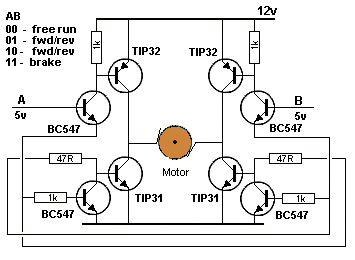boylesg
Advanced Member level 4

- Joined
- Jul 15, 2012
- Messages
- 1,023
- Helped
- 5
- Reputation
- 10
- Reaction score
- 6
- Trophy points
- 1,318
- Location
- Epping, Victoria, Australia
- Activity points
- 11,697
I am actually going to have to use this h bridge design because the inputs to my h bridge are coming from a 5V AND gate.

My current design will not put the full rail voltage of 12V on to my load.
But if I was to make my rail voltage 20V could you please explain how to recalculate the resistor values.
Also when A is turned on, what voltage and current is the base of the right bottom TIP31 going to see?
'A' is not an emitter follower so I calculate at between 5V and 12V and about 275mA which would be close to saturating that TIP31?

My current design will not put the full rail voltage of 12V on to my load.
But if I was to make my rail voltage 20V could you please explain how to recalculate the resistor values.
Also when A is turned on, what voltage and current is the base of the right bottom TIP31 going to see?
'A' is not an emitter follower so I calculate at between 5V and 12V and about 275mA which would be close to saturating that TIP31?





